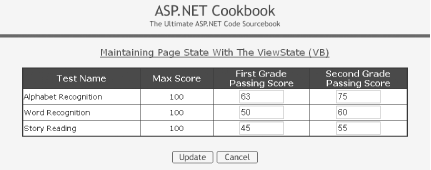6.4. Preserving Information Across Multiple Requests for a Page
Problem
You have a page that contains complex object information you need to preserve between requests for the page. The data contains information you do not want to be readable in the rendered HTML, and you do not want to use a database to preserve the information.
Solution
Use the ViewState property of the
Page object to store the data. You can then access
the data when the page is submitted back to the server.
In the code-behind class for the page, use the .NET language of your
choice to add all the code necessary to handle the storage and
recovery of the object data to and from the
ViewState.
In a separate class file, use the .NET language of your choice to
define the container in which you will store the data in the
ViewState.
The application that illustrates this solution is shown in Examples
Example 6-14 through Example 6-18.
Example 6-14 shows the .aspx
file. Example 6-15 and Example 6-16 show the VB and C# code-behind files. Examples
Example 6-17 and Example 6-18 show
the VB and C# data service class. Figure 6-4 shows
the form produced by the application.

Figure 6-4. Maintaining page state with ViewState
Discussion
The ViewState is an object similar to the
Application and Session objects
discussed in the previous recipes; however, its method of data
storage is quite different. Unlike the Application
and Session objects, ...
Get ASP.NET Cookbook now with the O’Reilly learning platform.
O’Reilly members experience books, live events, courses curated by job role, and more from O’Reilly and nearly 200 top publishers.

